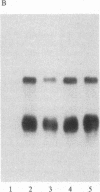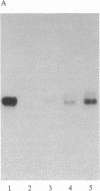Abstract
Like many primary tumors, human adenovirus type 12 (Ad12)-transformed mouse cells express greatly reduced levels of the major histocompatibility complex (MHC) class I antigens and are highly tumorigenic in immunocompetent hosts. Expression of a transfected class I gene by these cells can abrogate their tumorigenicity. Both the K and the L class I genes can suppress the malignant phenotype. Previous studies showed that interferon can induce class I gene expression in certain Ad12-transformed cells and can suppress their tumorigenic phenotype. We now demonstrate that preimmunization of mice with a nontumorigenic dose of interferon-treated Ad12-transformed tumor cells can afford protection against a subsequent challenge by a tumorigenic dose of untreated Ad12-transformed tumor cells. Similar immunity can also be induced by using cells transfected with the K gene, and the observed protection appears specific to Ad12-transformed cells. Significant protection can be achieved even if immunization is provided subsequent to the tumor challenge. Since increasing numbers of human tumors have been found to have reduced levels of MHC class I antigens, the prospect of therapy by immunization with the parental tumor cells that have been manipulated to induce class I gene expression offers an attractive experimental model.
Full text
PDF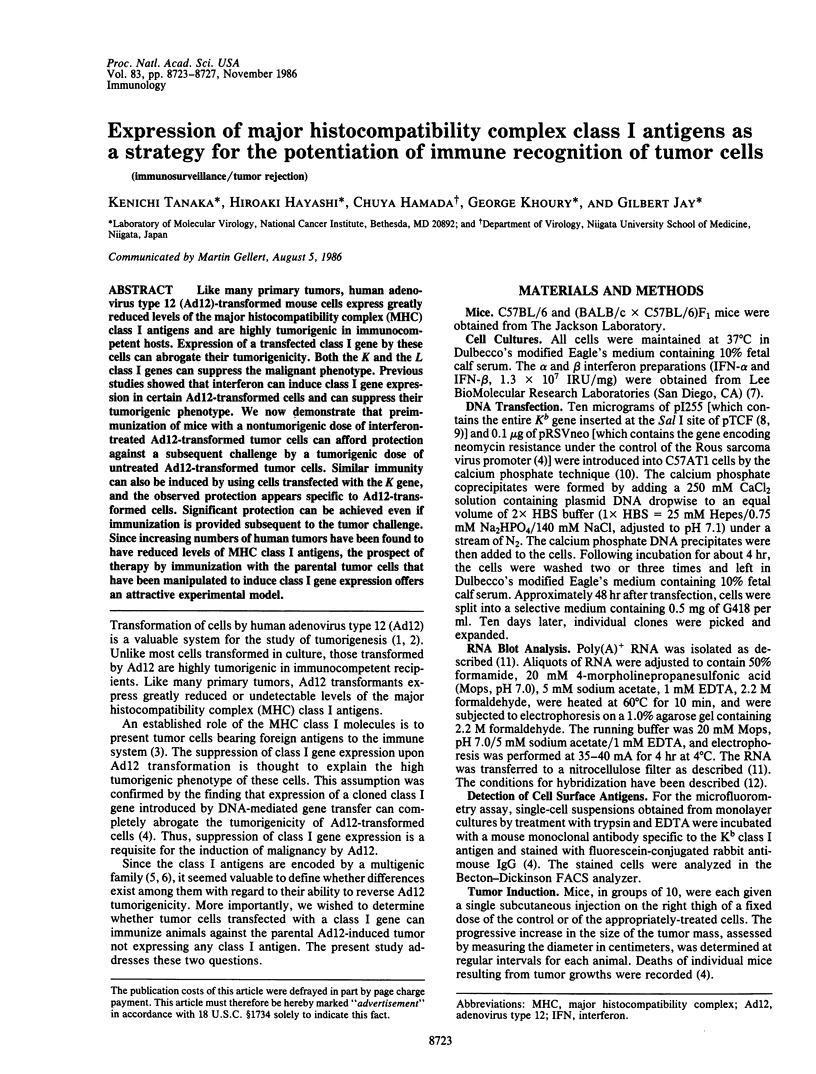
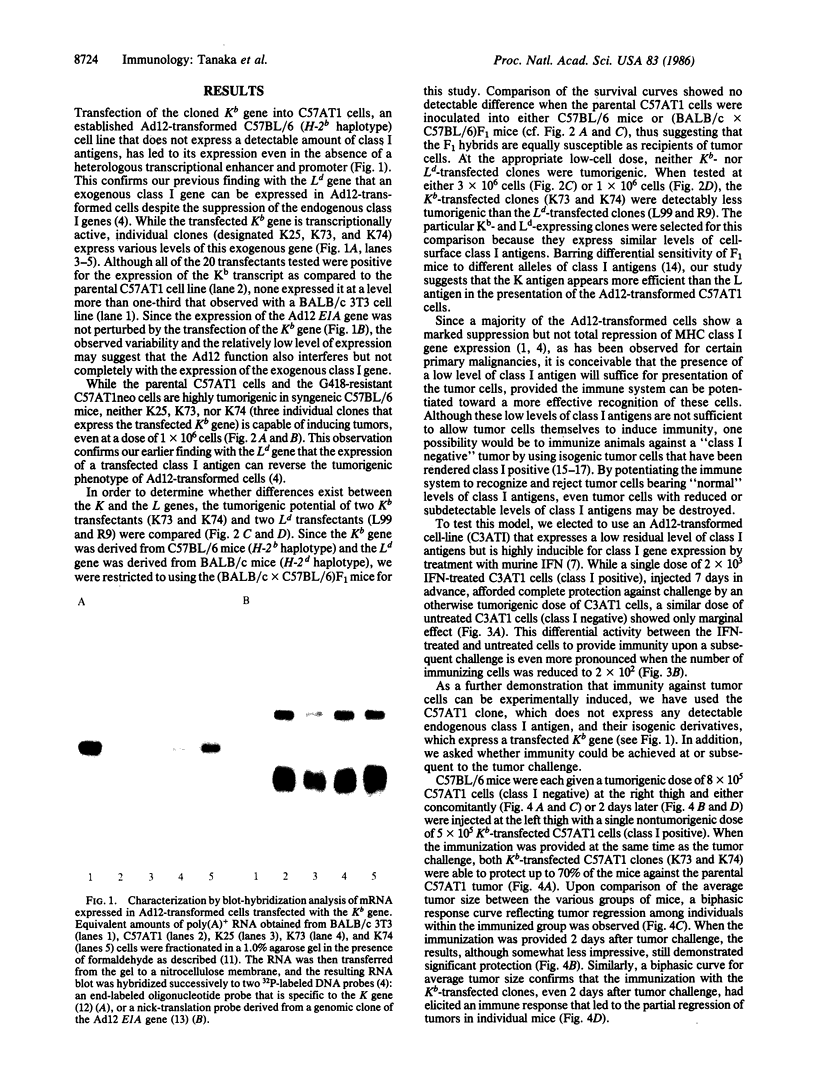
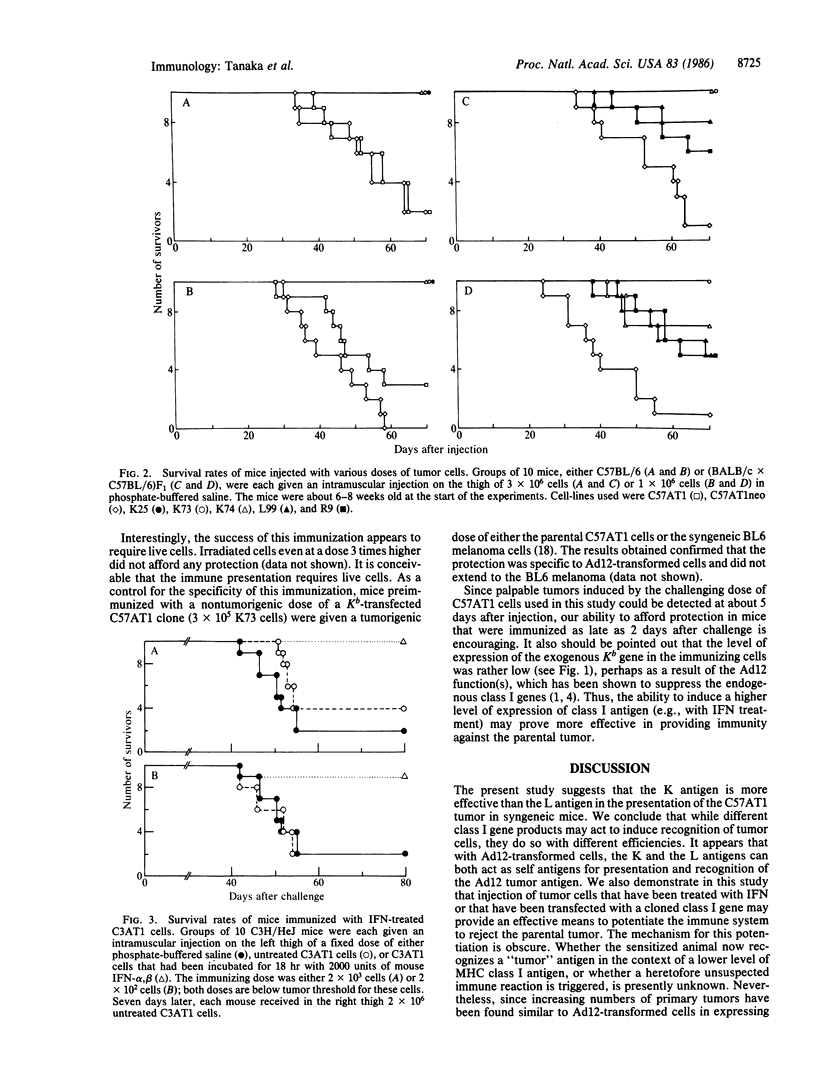
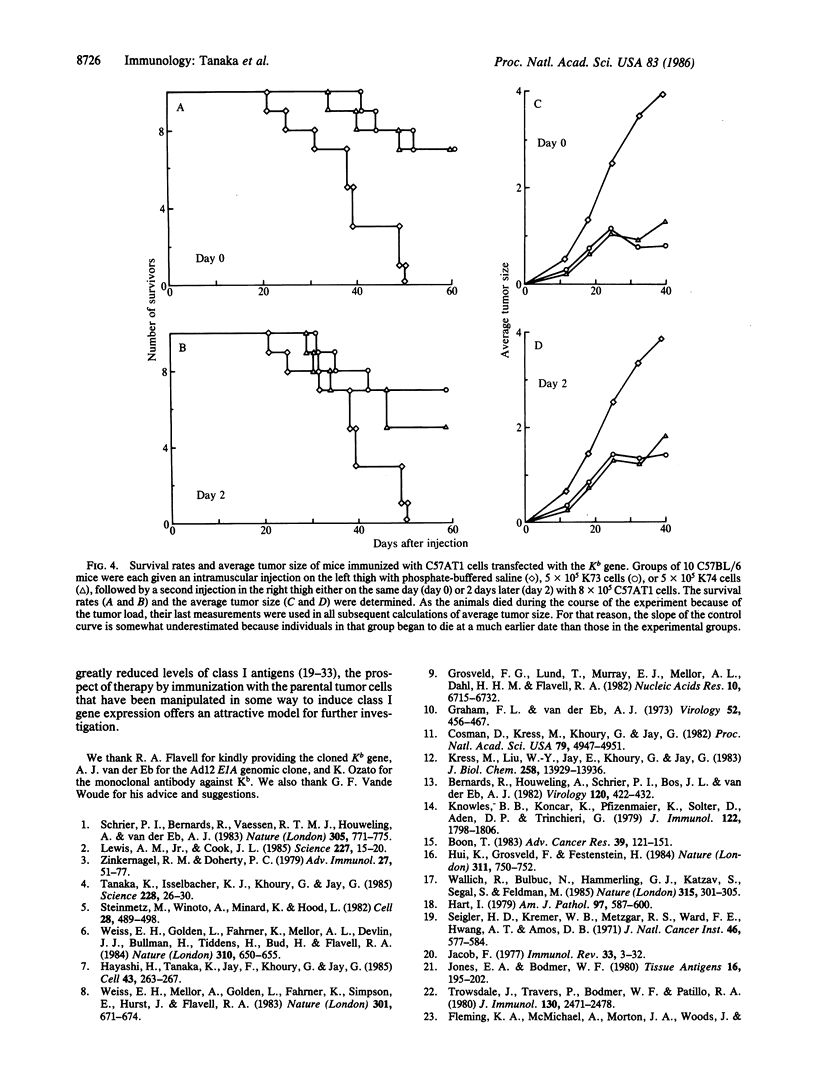
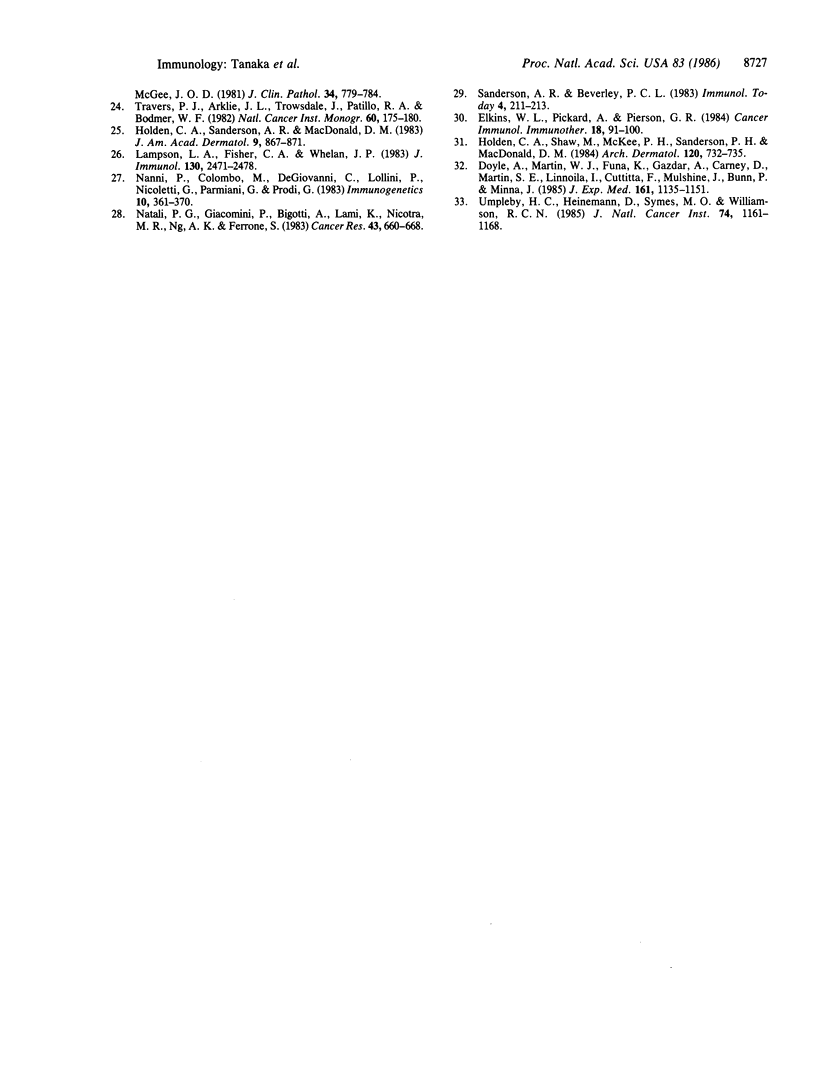
Images in this article
Selected References
These references are in PubMed. This may not be the complete list of references from this article.
- Bernards R., Houweling A., Schrier P. I., Bos J. L., Van der Eb A. J. Characterization of cells transformed by Ad5/Ad12 hybrid early region I plasmids. Virology. 1982 Jul 30;120(2):422–432. doi: 10.1016/0042-6822(82)90042-3. [DOI] [PubMed] [Google Scholar]
- Boon T. Antigenic tumor cell variants obtained with mutagens. Adv Cancer Res. 1983;39:121–151. doi: 10.1016/s0065-230x(08)61034-9. [DOI] [PubMed] [Google Scholar]
- Cosman D., Kress M., Khoury G., Jay G. Tissue-specific expression of an unusual H-2 (class I)-related gene. Proc Natl Acad Sci U S A. 1982 Aug;79(16):4947–4951. doi: 10.1073/pnas.79.16.4947. [DOI] [PMC free article] [PubMed] [Google Scholar]
- Doyle A., Martin W. J., Funa K., Gazdar A., Carney D., Martin S. E., Linnoila I., Cuttitta F., Mulshine J., Bunn P. Markedly decreased expression of class I histocompatibility antigens, protein, and mRNA in human small-cell lung cancer. J Exp Med. 1985 May 1;161(5):1135–1151. doi: 10.1084/jem.161.5.1135. [DOI] [PMC free article] [PubMed] [Google Scholar]
- Elkins W. L., Pickard A., Pierson G. R. Deficient expression of class-I HLA in some cases of acute leukemia. Cancer Immunol Immunother. 1984;18(2):91–100. doi: 10.1007/BF00205741. [DOI] [PMC free article] [PubMed] [Google Scholar]
- Fleming K. A., McMichael A., Morton J. A., Woods J., McGee J. O. Distribution of HLA class 1 antigens in normal human tissue and in mammary cancer. J Clin Pathol. 1981 Jul;34(7):779–784. doi: 10.1136/jcp.34.7.779. [DOI] [PMC free article] [PubMed] [Google Scholar]
- Graham F. L., van der Eb A. J. A new technique for the assay of infectivity of human adenovirus 5 DNA. Virology. 1973 Apr;52(2):456–467. doi: 10.1016/0042-6822(73)90341-3. [DOI] [PubMed] [Google Scholar]
- Grosveld F. G., Lund T., Murray E. J., Mellor A. L., Dahl H. H., Flavell R. A. The construction of cosmid libraries which can be used to transform eukaryotic cells. Nucleic Acids Res. 1982 Nov 11;10(21):6715–6732. doi: 10.1093/nar/10.21.6715. [DOI] [PMC free article] [PubMed] [Google Scholar]
- Hart I. R. The selection and characterization of an invasive variant of the B16 melanoma. Am J Pathol. 1979 Dec;97(3):587–600. [PMC free article] [PubMed] [Google Scholar]
- Hayashi H., Tanaka K., Jay F., Khoury G., Jay G. Modulation of the tumorigenicity of human adenovirus-12-transformed cells by interferon. Cell. 1985 Nov;43(1):263–267. doi: 10.1016/0092-8674(85)90031-5. [DOI] [PubMed] [Google Scholar]
- Holden C. A., Sanderson A. R., MacDonald D. M. Absence of human leukocyte antigen molecules in skin tumors and some cutaneous appendages: evidence using monoclonal antibodies. J Am Acad Dermatol. 1983 Dec;9(6):867–871. doi: 10.1016/s0190-9622(83)70200-8. [DOI] [PubMed] [Google Scholar]
- Holden C. A., Shaw M., McKee P. H., Sanderson A. R., MacDonald D. M. Loss of membrane B2 microglobulin in eccrine porocarcinoma. Its association with the histopathologic and clinical criteria of malignancy. Arch Dermatol. 1984 Jun;120(6):732–735. [PubMed] [Google Scholar]
- Hui K., Grosveld F., Festenstein H. Rejection of transplantable AKR leukaemia cells following MHC DNA-mediated cell transformation. Nature. 1984 Oct 25;311(5988):750–752. doi: 10.1038/311750a0. [DOI] [PubMed] [Google Scholar]
- Jacob F. Mouse teratocarcinoma and embryonic antigens. Immunol Rev. 1977 Jan;33:3–32. doi: 10.1111/j.1600-065x.1977.tb00360.x. [DOI] [PubMed] [Google Scholar]
- Jones E. A., Bodmer W. F. Lack of expression of HLA antigens on choriocarcinoma cell lines. Tissue Antigens. 1980 Aug;16(2):195–202. doi: 10.1111/j.1399-0039.1980.tb00603.x. [DOI] [PubMed] [Google Scholar]
- Knowles B. B., Koncar M., Pfizenmaier K., Solter D., Aden D. P., Trinchieri G. Genetic control of the cytotoxic T cell response to SV40 tumor-associated specific antigen. J Immunol. 1979 May;122(5):1798–1806. [PubMed] [Google Scholar]
- Kress M., Liu W. Y., Jay E., Khoury G., Jay G. Comparison of class I (H-2) gene sequences. Derivation of unique probes for members of this multigene family. J Biol Chem. 1983 Nov 25;258(22):13929–13936. [PubMed] [Google Scholar]
- Lampson L. A., Fisher C. A., Whelan J. P. Striking paucity of HLA-A, B, C and beta 2-microglobulin on human neuroblastoma cell lines. J Immunol. 1983 May;130(5):2471–2478. [PubMed] [Google Scholar]
- Lewis A. M., Jr, Cook J. L. A new role for DNA virus early proteins in viral carcinogenesis. Science. 1985 Jan 4;227(4682):15–20. doi: 10.1126/science.3843807. [DOI] [PubMed] [Google Scholar]
- Nanni P., Colombo M. P., De Giovanni C., Lollini P. L., Nicoletti G., Parmiani G., Prodi G. Impaired H-2 expression in B16 melanoma variants. J Immunogenet. 1983 Oct;10(5):361–370. doi: 10.1111/j.1744-313x.1983.tb00348.x. [DOI] [PubMed] [Google Scholar]
- Natali P. G., Giacomini P., Bigotti A., Imai K., Nicotra M. R., Ng A. K., Ferrone S. Heterogeneity in the expression of HLA and tumor-associated antigens by surgically removed and cultured breast carcinoma cells. Cancer Res. 1983 Feb;43(2):660–668. [PubMed] [Google Scholar]
- Schrier P. I., Bernards R., Vaessen R. T., Houweling A., van der Eb A. J. Expression of class I major histocompatibility antigens switched off by highly oncogenic adenovirus 12 in transformed rat cells. 1983 Oct 27-Nov 2Nature. 305(5937):771–775. doi: 10.1038/305771a0. [DOI] [PubMed] [Google Scholar]
- Seigler H. F., Kremer W. B., Metzgar R. S., Ward F. E., Haung A. T., Amos D. B. HL-A antigenic loss in malignant transformation. J Natl Cancer Inst. 1971 Mar;46(3):577–584. [PubMed] [Google Scholar]
- Steinmetz M., Winoto A., Minard K., Hood L. Clusters of genes encoding mouse transplantation antigens. Cell. 1982 Mar;28(3):489–498. doi: 10.1016/0092-8674(82)90203-3. [DOI] [PubMed] [Google Scholar]
- Tanaka K., Isselbacher K. J., Khoury G., Jay G. Reversal of oncogenesis by the expression of a major histocompatibility complex class I gene. Science. 1985 Apr 5;228(4695):26–30. doi: 10.1126/science.3975631. [DOI] [PubMed] [Google Scholar]
- Travers P. J., Arklie J. L., Trowsdale J., Patillo R. A., Bodmer W. F. Lack of expression of HLA-ABC antigens in choriocarcinoma and other human tumor cell lines. Natl Cancer Inst Monogr. 1982;60:175–180. [PubMed] [Google Scholar]
- Umpleby H. C., Heinemann D., Symes M. O., Williamson R. C. Expression of histocompatibility antigens and characterization of mononuclear cell infiltrates in normal and neoplastic colorectal tissues of humans. J Natl Cancer Inst. 1985 Jun;74(6):1161–1168. [PubMed] [Google Scholar]
- Wallich R., Bulbuc N., Hämmerling G. J., Katzav S., Segal S., Feldman M. Abrogation of metastatic properties of tumour cells by de novo expression of H-2K antigens following H-2 gene transfection. Nature. 1985 May 23;315(6017):301–305. doi: 10.1038/315301a0. [DOI] [PubMed] [Google Scholar]
- Weiss E. H., Golden L., Fahrner K., Mellor A. L., Devlin J. J., Bullman H., Tiddens H., Bud H., Flavell R. A. Organization and evolution of the class I gene family in the major histocompatibility complex of the C57BL/10 mouse. Nature. 1984 Aug 23;310(5979):650–655. doi: 10.1038/310650a0. [DOI] [PubMed] [Google Scholar]
- Weiss E. H., Mellor A., Golden L., Fahrner K., Simpson E., Hurst J., Flavell R. A. The structure of a mutant H-2 gene suggests that the generation of polymorphism in H-2 genes may occur by gene conversion-like events. Nature. 1983 Feb 24;301(5902):671–674. doi: 10.1038/301671a0. [DOI] [PubMed] [Google Scholar]
- Zinkernagel R. M., Doherty P. C. MHC-restricted cytotoxic T cells: studies on the biological role of polymorphic major transplantation antigens determining T-cell restriction-specificity, function, and responsiveness. Adv Immunol. 1979;27:51–177. doi: 10.1016/s0065-2776(08)60262-x. [DOI] [PubMed] [Google Scholar]



